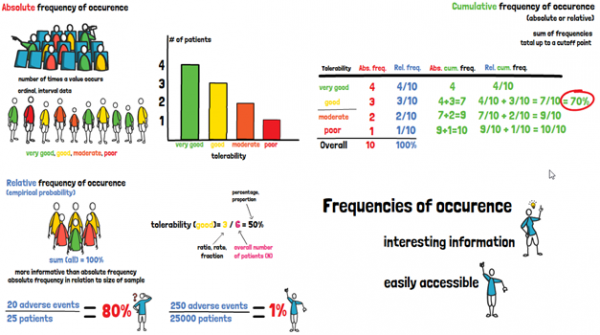Descriptive statistics present a good first overview of the data. The frequency of occurrence, as part of descriptive statistics, provides information that is easy to extract and to understand. There are three different types of frequencies, the absolute, the relative and the cumulative frequency. The absolute frequency of occurrence is the number of times a value occurs or is recorded. Absolute frequencies can be shown for ordinal or interval data and are often presented graphically in histograms, where the height of the bars represents the number of patients within the defined category. The intervals are usually specified as consecutive categories of a variable. They must be adjacent and are often chosen to be of the same size. Relative frequency, or also called empirical probability, is obtained from absolute frequencies divided by the overall number of subjects included in the trial or a certain subgroup being investigated. It is referred to as percentage, proportion, ratio, rate, or fraction dependent on overall number of patients. The sum of all relative frequencies is equal to 1 or 100%. Relative frequency is more informative than absolute frequency because it puts the absolute frequency in relation to the size of the sample being looked at. Observing twenty adverse events in a trial of twenty-five patients may be concerning. On the other hand, 250 adverse events in a sample of 25000 patients, meaning a relative frequency of 1%, is likely to be a very good outcome. What matters is the perspective that is provided by the relative frequency! The cumulative frequency is the sum of frequencies (either absolute or relative) of all the values equal to or less than a considered cut off point. The relative cumulative frequency is the result of dividing the absolute cumulative frequency by the total number of patients or just summing up all relative frequencies up to that threshold.

If you are interested in a visual presentation of this topic, please feel free to follow us on our GCP Mindset YouTube channel! If you would like to know more about how we could implement statistics in your clinical trial, send us a mail at statistics@gcp-service.com.





